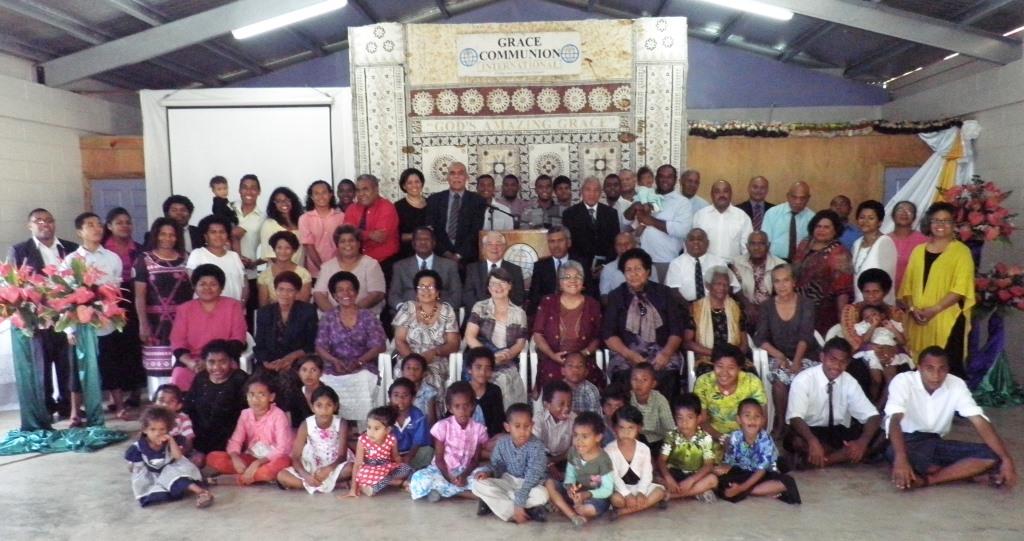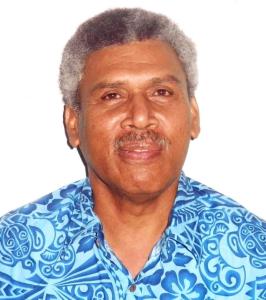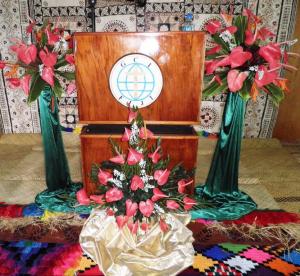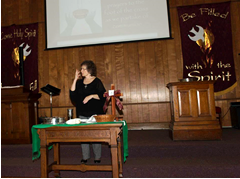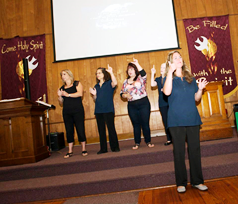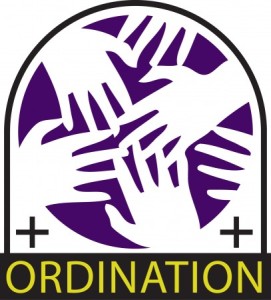In an essay entitled “Guidelines to an Understanding of the Person and Work of the Holy Spirit,” Dr. Gary Deddo offers an incarnational, Trinitarian perspective on the doctrine of the Holy Spirit. We are publishing his essay serially in seven parts. Here is part three (to read other parts, click on a number: 1, 2, 4, 5, 6, 7).
The Triune God: one in being, three distinct Divine Persons
Last time we saw that God is one in being and yet exists eternally as three distinct Divine Persons: Father, Son and Holy Spirit. In seeking to communicate this truth about God, some use the catch-phrase, one-in-three and three-in-one. Though it’s not wrong, it can be misleading if people understand it to mean that God is both three and one of the exact same thing. But God is not one and three beings; nor is he one and three Persons. The “oneness” and the “threeness” of God refer to two aspects of who God is. “One” refers to God’s one being while “three” refers to the three Divine Persons. To more accurately convey this truth, I recommend this statement: God is one in being and three in Divine Persons. Now, let’s unpack that statement and begin to focus on the main topic of this essay: the Divine Person known as the Holy Spirit.
Three Divine Persons
When we say “three Divine Persons,” we don’t mean “persons” exactly like you and me. We humans are created in the image of God, but God is not an image of us. Divine Persons are not exactly the same as human persons. If God was three persons exactly like we are, then God would be three beings, since human persons are separate beings. When speaking about God, we’re not using the word “person” in exactly the same way we do about ourselves.
Recall that the discipline of theology is to make sure we don’t talk about God as if God was a creature. We have to avoid projecting human ideas on God. This discipline of theology takes a while for people to catch on to but that is why in the church, we’re actually teaching people to think about God according to God’s nature, not to think about God, for example, as a big human being in the sky!
In speaking of the Father, Son and Holy Spirit as Divine (not human) Persons, we are affirming that these personal names and personal relationships between them reveal to us the reality of God. God knows himself as Father, Son and Spirit. There are real and eternal relationships in God. Elsewhere in Scripture these relationships are also characterized as a mutual knowing, loving, glorifying and oneness. What we think about human persons in living, loving and holy relationship with each other does, to a certain degree, reflect the truth about God. God is more like a community of three human persons than like any other created thing. Or, it would be better to switch this around and say that the Father, Son and Holy Spirit are the original and real Persons, and since we are somewhat like them, we can borrow the term “person” to speak of ourselves as individual human creatures! But God is not more like a single, lonely, isolated individual. He is not, as the philosopher Leibnitz declared, a Monad!
Perichoresis and triunity
Reflecting on the unity and distinction of the Divine Persons, some down through the ages have thought of the church as imaging the Trinity: one in Christ, yet many members. But the church does not and cannot have the same kind of unity as do the three Divine Persons. Their unity is their oneness of being. Our unity cannot match that. The kind of unity that God has is revealed to us in Jesus Christ. It is a unity so unique that early church teachers eventually coined a word to represent that one-of-a-kind divine unity. That word is perichoresis. It is Greek and often is not translated because it has a unique meaning that can’t be translated easily. It means, most literally, to envelope one another or to make space for one another. It has also been translated as mutually indwelling each other, or having a coinherence in each other, or in-existing in one another.
The language of perichoresis represents Jesus’ teaching that he is “in the Father and the Father is in [him]” (John 14:11). It is also just what we see lived out in the Gospels as we watch and hear Jesus in his dynamic relationship with the Father and the Spirit. This unique unity has been also explained by saying that the whole of God, all three Persons, are present in each of the Persons. Each, though fully God in being, is distinct in Person so that there is a real relationship and exchange going on from all eternity between the three Divine Persons. As one fairly early creed (The Athanasian Creed) summed it up: the unity of God is a Trinity and the Trinity of God is a Unity. We can try to put this truth into a single word: triunity.
Everything we can say about the Father we can say about the Son and we can say about the Spirit except that they are not each other. Why? Because they mutually indwell one another and so equally are God, sharing all the divine attributes together as one God. They have an absolutely unique kind of unity so that they are distinct in Divine Person but united in being. Unlike creatures, the unity of being doesn’t undo the difference of Person, and the distinction of Person doesn’t undo the unity of being. Remembering this will help us get our language squared away so that we don’t grossly misrepresent God.
What kind of God?
The meaning of what we’re saying here about God is, of course, deep and profound. It’s beyond our most descriptive words, for words are incapable of fully explaining the nature of God. The early church understood that the purpose of words (as in our doctrinal formulations) was to protect the mystery of God’s nature, not explain it away. Nevertheless our words about God are important, as far as they go, in faithfully identifying who God is. When carefully stated in the context of all of Scripture, they show us something significant about the kind of God this God is. They point to the fact that God has his being by being a fellowship, a communion of Divine Persons. Along with the biblical writers, we can sum up the quality of those relationships as all being forms of love. Begetting, being begotten and proceeding are all relationships of loving exchange.
This is why we can say with John, “God is love.” And we can see what Jesus means and why he says he loves the Father and the Father has loved him from all eternity. It makes sense then that Jesus tells us that as the Father has loved him, so he loves us. And further, that as he has loved us, so we ought to love one another. No wonder then that the ways of the people of God can be comprehensively summed up in the two commands to love God and love neighbor.
Those relationships, internal and eternal to God, are filled with holy loving. God is a fellowship kind of God—a communion kind of God. God is not just a lonely being floating out there from all eternity “looking for someone to love.” God is the fullness of holy love, the fullness of fellowship and communion. Bringing it all together, we can say the Father and Son have their fellowship and communion in the Spirit.
This God of love, fellowship and communion is very different than an isolated individual God who can’t love until there’s something else outside of God to love. The Triune God is very different from a god who exists with no internal and eternal relationships, one in whom there is no exchange, no giving and receiving, in whom there is no reciprocity of knowing, loving and glorifying of one another. Such a god would be very different from the God we come to know through Jesus Christ, according to Scripture.
To summarize: the Christian God is a fellowship, a communion. God the Trinity has his being by being in relationships of holy loving. Those relationships are, in particular, eternally begetting, being begotten and proceeding—each a unique form of holy, loving exchange. Those are the key words that we have to point to this amazing reality of who God is.
Those are the essentials to remember if we’re going to go on and talk about the Holy Spirit. We have to remember who the Spirit is. And if the Spirit first exists in relationship with the Father and the Son, then that’s the first thing, not the Spirit’s relationship to us or our relationship to the Spirit. Those come afterwards. There was a time when nothing other than God existed and the Holy Spirit was perfectly happy being the Spirit of the Father and the Son. The Spirit doesn’t need us to be the Spirit. There was a time when there was no creation. At that time God was the fullness of fellowship in Father, Son and the Holy Spirit.
While we want to talk about the Spirit’s relationship to us we should remember that that’s a secondary matter. The being of the Spirit is being one with the Father and the Son. Having completed an introduction to Trinitarian doctrine, what can we go on to say about the Holy Spirit?
Who is the Holy Spirit?
In answer to the question, who is the Spirit? the simplest answer is that the Spirit is the Spirit of the Father and the Son. That means that whenever we speak of the Father and Son, or hear about them in the Scripture, since God is one in being, the Spirit is also involved in some way, whether we know it or not or explicitly say so. The Spirit always has something to do with the Father and Son. It’s true that we don’t always remember this connection. And we probably should make it more explicit more often. So, when speaking of the Father or the Son we do not exclude the Spirit, because the Spirit’s the Spirit of the Father and the Son. Reference to the Son involves the Spirit and the other way around. We can’t talk about the Holy Spirit apart from the Son because the Holy Spirit is the Spirit of the Son.
If we assume we can think of one without the other, we’re misrepresenting who the Spirit is because the Spirit has his being, is the Person he is, by being in an essential relationship to the Father and Son. We don’t always spell this all out, but nevertheless we should remember to make all the connections. So certainly a full understanding will always seek to grasp each of the divine Persons in their relationships with each other.
The who, not how of the Spirit
Seeking further understanding, we often look for answers to “how” questions. This is particularly the case when the topic is the Holy Spirit. We ask “how” questions like, How does God operate his providence over all of history and nature and everything else? Or, How did Jesus become united to a human nature? Or, How did God save us? Or, How does God perfect us? Or, How does God communicate his word and will to us? Or How do we receive the gifts and fruit of the Spirit or the help of the Spirit in prayer?
Many of the “how” questions about God actually are answered by a “who” answer, which points directly to the Spirit. The answer to “how” God does something often is, simply, “by the Spirit.” Such a “who” answer, although specifically naming one of the Triune Persons, often is regarded as insufficient. The follow-up questions reveal why. We want to know the mechanisms, the machinery. We want to know the chain of cause and effect. Somehow we have come to believe that simply identifying the agent responsible for what takes place does not constitute an intelligible answer. So we press on to the “how” question. But often in Scripture, the only answer given to a “how” question, is simply the identification of the agency of the Holy Spirit. We are simply told who does something and that, in many cases, is the full extent of the explanation. Question: How? Answer: By the Holy Spirit! The truth is, we can know the “who,” without knowing the “how”!
Did Jesus tell Nicodemus the mechanism of how one becomes born from above? Did he offer him a technique? Did he list a bunch of rules that if we do this and that and the other, then bingo, it happens? No. He explained that, because the Spirit works more like the wind, there can be no such kind of explanation given. The working of the Spirit can’t be controlled or predicted by us. That’s the nature of the Spirit–both who he is and how he works!
Many of our questions, especially those regarding the Christian life, are answered simply by identifying the agency of the Holy Spirit. And that’s it. But we always seem to want more that involves some mechanism, technique or steps. We feel that there needs to be some combination of conditions filled in order to get the Spirit to work. There is quite a bit of teaching in Christian circles these days that speculates and even invents techniques and methods to fill in the gap between what biblical revelation teaches and what we, like Nicodemus, often want—answers to our “how” questions that specify exactly what conditions we need to fill to get the Spirit to work, or work more effectively. However, shouldn’t we stop where Scripture stops rather than carry on with mere speculations?
In fact, many of the current controversies or differences of emphasis between various teachings and ministries actually have to do with their lining up behind a favorite technique or mechanism or a particular list of conditions needed to get what we’re looking for from the Spirit. The arguments and controversies are most often over which teaching offers the best “how to.” But if we go down that road, we’ve already forgotten most of who the Spirit is. On that path we can easily be tempted to start asking all kinds of questions. Some can mistakenly assume God can be divided up. So the question arises, “Can you have the Spirit without having the Son?” Or, “Can you have the Son without having the Spirit?” Others assume that the presence and blessing of the Spirit comes not by grace but by technique or by fulfilling certain conditions and so they ask “What steps do we need to take before we can effectively have and use the gifts of the Spirit?” But such an approach makes the grace of the Holy Spirit dependent upon our works, our efforts! The result is that we then approach the Spirit by works rather than by faith in God’s grace! We replay the exact same error that Paul wrote the church in Galatia about.
“By the Spirit of the Father and Son” answers these “how” questions. Of course, we can try to use all kinds of Bible verses to work out answers to these questions and controversies. But the problem with that approach is that the nature and character of the Holy Spirit is forgotten, even lost. For example, if the Father, Son and Holy Spirit are one in being, can you then have one without the other? No you can’t, not in an exclusive way. You can’t have one completely without the other. The unity of the Persons in action is indicated in biblical revelation where we are told that no one truly proclaims Jesus is Lord except by the Spirit (1 Corinthians 12:3). We are told that when the Spirit of sonship comes upon us, we cry out “Abba Father” (Romans 8:15; Galatians 4:6). God doesn’t split up, with the Son heading off saying, “Goodbye, Spirit. I hope you catch up later.” God is one in being but also God is one in action. They act and work together.
Many if not most current controversies have forgotten some of the most fundamental things about who God the Holy Spirit is. Our thoughts can then head in all sorts of wrong directions and we end up speculating in order to answer misguided questions. We can just grab random Bible verses and try to throw them together to come up with an answer. As a result, different groups ended up gravitating toward certain verses to prove their points. But in doing so, they left behind the more fundamental teaching that points to the reality of who the Spirit is. The fundamental thing, the answer to the “who” question regarding the Spirit, is often forgotten and so the answers promoted are inconsistent with the deeper, more central truth of the Spirit who is one in being and one in working with the Father and the Son and who ministers by grace.
Biblical revelation about the ministry of the Spirit is often presented in connection with the mention of at least one other Divine Person. Scripture tells us that only the Holy Spirit can break into a person’s pride and enable them to recognize that Jesus really is their Lord and Savior, come in the flesh as one of us (1 John 4:2). It tells us that we only have the Spirit because he is sent by the Son, from the Father (John 15:26). It also says that if anyone is convicted by the message of the gospel, it is because the Spirit is at work (1 Thessalonians 1:3-5). As Scripture declares that Jesus sends the Spirit to bring persons to an acknowledgment of sin and the need for judgment and righteousness (John 16:8).
When the “Spirit of sonship” comes upon us, we cry out “Abba Father,” Paul tells us (Romans 8:15; Galatians 4:6). Why do we cry out “Abba Father”? If we know who the Spirit is, the answer is obvious—because God is one in being and one in action. Isn’t that amazing? The whole Trinity is involved in that one simple and profound cry of our hearts. When the Spirit acts, he doesn’t act apart from the Father but with the Son, too, brings our worship all together.
So, when Jesus says “Go out and baptize them in the name” (singular) and then gives them the one name: “Father, Son and Holy Spirit,” we should not be surprised. The name we’re given matches the reality: Father, Son and Holy Spirit is the one name of God. A simple way to say this is that God is the Father-Son-Holy-Spirit-God, as if it’s one name instead of three names because it really isn’t three separate names, but a threefold-name. We’re baptized into the one Name of the three Divine Persons. Jesus’ instruction makes sense if that’s who God is, and so how God acts and has his being as the Triune God—one in being and three in Divine Persons.
All our thinking about the Holy Spirit needs to be contained within these Trinitarian boundaries. That will help us interpret Scripture properly and also see more deeply into Scripture so that we come to know the reality of who the Spirit is ever more profoundly. Good theology doesn’t take us away from Scripture—it helps us see how it comes together even more coherently. Good theology doesn’t answer every question we might have, but it does answer the questions God most wants us to grasp and proclaim. So, we want to help others read Scripture, interpret Scripture and bring all the pieces of Scripture together.
Next time we’ll look further at the importance of the Holy Spirit.
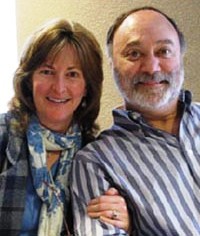 For many years, I fasted on Yom Kippur, the Jewish High Day referred to as the Day of Atonement. I did so wrongly thinking that abstaining from food and drink on that day was reconciling me to God. Many of you recall that erroneous reasoning. But no matter how it was presented to us at the time, fasting on Yom Kippur for that purpose meant trying to maintain our Atonement (at-one-ment) with God through our own works. We were practicing a religious system of grace plus works—one that overlooked the reality that Jesus is our Atonement.
For many years, I fasted on Yom Kippur, the Jewish High Day referred to as the Day of Atonement. I did so wrongly thinking that abstaining from food and drink on that day was reconciling me to God. Many of you recall that erroneous reasoning. But no matter how it was presented to us at the time, fasting on Yom Kippur for that purpose meant trying to maintain our Atonement (at-one-ment) with God through our own works. We were practicing a religious system of grace plus works—one that overlooked the reality that Jesus is our Atonement.




